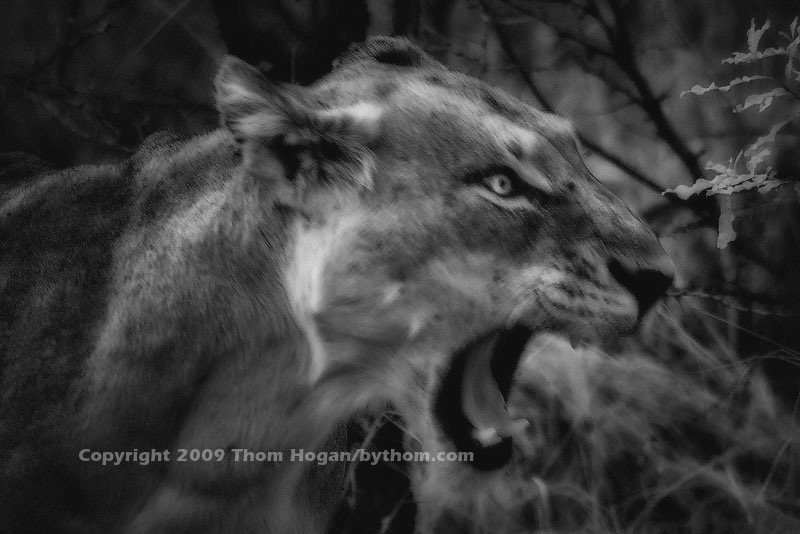
It's early in the evening and there's not much light left. You're right alongside a lioness trying to defend her territory. She's moving as she thrusts and parries. Basically, you're stretched further than you want to go: ISO 6400, 1/60, an autofocus system that's struggling and not always getting the focus point right. Do you keep taking photos?
You bet you do.
A lot of the most impactful photos over the ages have actually been ones where the technical details didn't quite get mastered. Remember, photos are about moments. When you show them to people, you want them to have impact. In some ways, an absolutely perfectly exposed, focused, and managed photo of a spontaneous moment in time will often look a bit artificial. Too precise. People start to ask you how you staged the photo because you couldn't possibly have controlled everything so well in the heat of the moment.
This image is black and white because it has significant color noise in it. If I took all that noise out, then I get the plastic look that's a dead giveaway for digital images. By popping over to black and white, I've managed to hide a lot of the noise as faux detail. The camera misfocused too, managing to put the focus point behind the lion. It didn't help that the 1/60 shutter speed didn't stop all of the lion's motion, either. Yet (I hope) something else is coming across: this has to be a spontaneous moment, one that I was reacting to in real time.
Yes, I am very close to the lion. That's 200mm and the complete DX frame. Note that the lioness has no interest at all in me. LIke me, she's reacting to the situation in front of her spontaneously, trying to control what she can control. In that respect, we're both alike here, subject and photographer: we're both on the hairy edge of what we can control. She's alone with a cub against two large males she doesn't want around. I'm alone with a camera that's taken way beyond its capability (this was a D90 and the 55-200mm).
I've got a couple of other photos in this sequence that are better focused, one where there's a little more light on the lioness, and some where she's not moving. But they don't have the impact of this one because photos are about moments, and this is the moment when she told the trespassers that she was all in. And it worked. The males backed off and she quickly backtracked to her cub and they went off the other way.
Sometimes there is literally a 1/60 of a second to take a picture. Take it. If you fiddle with your settings, or decide to change lenses, or just wait for the camera to grab focus, you won't hit that 1/60. You never make the image you don't take, to paraphrase a famous hockey player. That's one thing great about digital: there's no cost penalty for taking an extra photo. You can always erase it if it's a couple swing and a miss.
Some of my favorite photos are ones that don't have all the many technical aspects all dialed in perfectly. Indeed, with wild animals, I'd argue that the best photos look like they were taken in the wild (i.e., not perfect).
